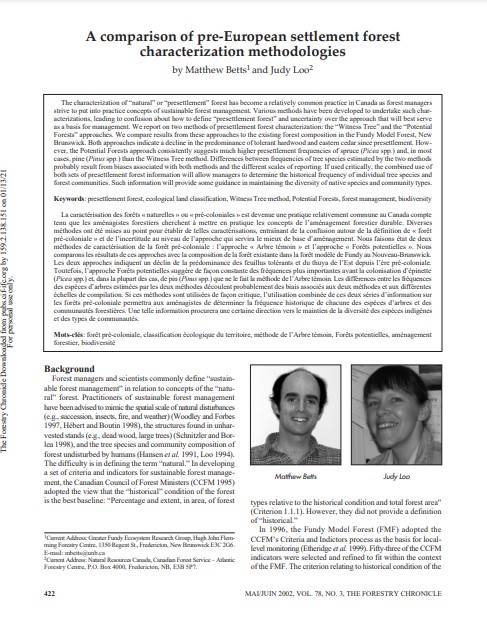A comparison of pre-European settlement forest characterization methodologies
Bosque Modelo:
Fundy
Temática:
Gestión forestal
Tipo de documento:
Artículo científico
Resumen
The characterization of “natural” or “presettlement” forest has become a relatively common practice in Canada as forest managers strive to put into practice concepts of sustainable forest management. Various methods have been developed to undertake such characterizations, leading to confusion about how to define “presettlement forest” and uncertainty over the approach that will best serve as a basis for management. We report on two methods of presettlement forest characterization: the “Witness Tree” and the “Potential Forests” approaches. We compare results from these approaches to the existing forest composition in the Fundy Model Forest, New Brunswick. Both approaches indicate a decline in the predominance of tolerant hardwood and eastern cedar since presettlement. However, the Potential Forests approach consistently suggests much higher presettlement frequencies of spruce (Picea spp.) and, in most cases, pine (Pinus spp.) than the Witness Tree method. Differences between frequencies of tree species estimated by the two methods probably result from biases associated with both methods and the different scales of reporting. If used critically, the combined use ofboth sets of presettlement forest information will allow managers to determine the historical frequency of individual tree species and forest communities. Such information will provide some guidance in maintaining the diversity of native species and community types.
Información Bibliográfica
Autor:
Betts, M and J Loo.
Revista:
Forestry Chronicle
Año:
2002
N°:
3
País :
Canadá
Páginas:
422 - 432
Volumen:
78
Idioma:
Ingles
Palabras claves
presettlement forest, ecological land classification, Witness Tree method, Potential Forests, forest management, biodiversity





